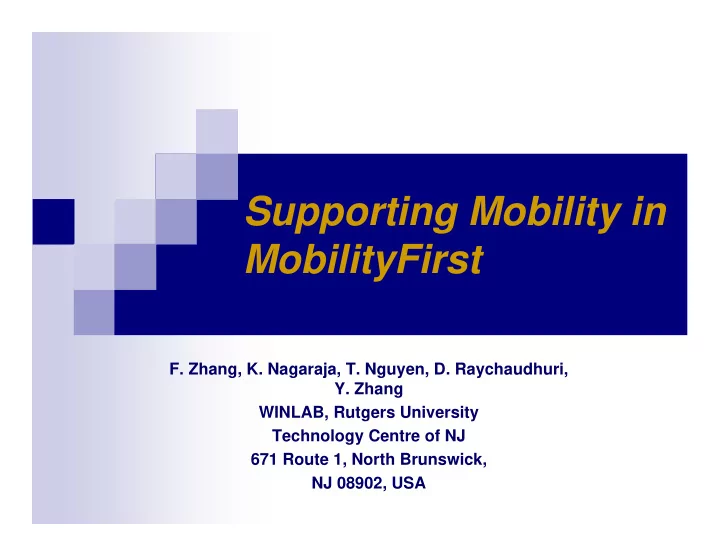

Supporting Mobility in MobilityFirst F. Zhang, K. Nagaraja, T. Nguyen, D. Raychaudhuri, Y. Zhang WINLAB, Rutgers University Technology Centre of NJ 671 Route 1, North Brunswick, NJ 08902, USA
Mobile Data Usage Forecast Mobile data [Cisco Visual Networking Index] Global mobile data traffic grew 2.3 fold in 2011 More than doubling for the fourth year in a row By the end of 2012, the number of mobile-connected devices will exceed the number of people on earth. Mobile cloud traffic Mainly medium Mobile cloud traffic will grow 28 fold from 2011 to 2016, will account for 71% (7.6 exabyets / month) of total mobile data traffic in 2016
Mobile Content
Mobility Support in MobilityFirst Device Mobility “Can I download a movie while riding the taxi to EWR?” Content Retrieval and Content Mobility “ Can I access the content copy that is close to me? ” Dynamic Context “Can I send a message to all the people who are attending the Winlab IAB?”
Globally Unique Identifier (GUID) Sue’s_mobile_2 Each device/content/context has a Server_1234 human-readable name (HRN) and Media File_ABC Taxis in NB a globally unique ID (GUID) Sensor@XYZ John’s _laptop_1 Many existing work on creating HRNs Host Sensor Context Content Naming Naming Naming GUIDs are flat, randomly Naming Service Service Service Service generated bits (possibly from Globally Unique Flat Identifier (GUID) public key), without any semantic Global Name Resolution Service structure Network ~ 160 bits Name assignment service (NAS): domain-specific service Translating HRNs to GUIDs Net2.local_ID 5
Basic Mobility Support Through Host H AS1 Network Address Publishing AS1 GUID 1. GUID H GNRS GNRS
Basic Mobility Support Through GNRS GUID Network Address H AS1 GNRS 1. GUID Publishing 2. GNRS lookup AS1 3. GNRS Reply: AS1 for H 4. Data request Host H requestor 5. Data reply
Basic Mobility Support Through AS2 Host H AS1 Network Address AS1 GUID H GNRS GNRS
Host H Basic Mobility Support Through AS2 AS1 Network Address GUID update AS1 1. GUID H GNRS GNRS
Host H Basic Mobility Support Through AS2 AS1 Network Address GUID update AS2 1. GUID H GNRS GNRS
A Shared-Hosting GNRS through Direct Map (D-Map) GUID (00101100……10011001) Hash Function IP IP x = (44.32.1.153) (+) Strictly 1-overlay-hop lookup No extra routing requirement (e.g. utilize current BGP)
Mapping Replication Every mapping is replicated at Keeping a local copy within the K random locations source AS Lookups can choose closest LNRS vs GNRS among K mappings. Much reduced lookup latencies Local replica GUID AS# AS 1 10 1 (00101100……10011001) GUID GUID 10 GUID update AS 200 AS 5 k Hash Functions K=1 K=3 IP x = (44.32.1.153) IP AS 101 IP IP x = (67.10.12.1) GUID AS# IP GUID AS# IP x = (8.12.2.3) K=2 10 1 10 1 GUID AS# 10 1
In-network Caching Intermediate routers can choose to cache GNRS mappings Each GUID update has a TTL field Entry is evicted from the cache when TTL expires Mobile needs to estimate its stay time when it GUID AS# associates to a new network G AS2 AS 23973 AS 26 (G, AS2) GUID update AS 2 (G, AS2) (G, AS2) GUID Update GUID (G, AS2, 2 update hours) (G, AS2) 13
Case Study I: Content Download on the Go GUID Network Address Content AS 239 GNRS Mobile AS 1 AS 239 AS 1 content request content reply 14
Case Study I: Content Download on the Go GUID Network Address Content AS 239 GNRS Mobile AS 2 AS 2 content AS 239 reply AS 1 15
Case Study II: Dynamic Content Caching GUID Network Address Content AS 239 GUID lookups GNRS Content requests AS 239 16
Case Study II: Dynamic Content Caching GUID lookups GUID mapping cache GUID Network Address Content AS 239, GNRS cache1, cache 2 Content requests Content cache 1 Content AS 239 cache 2 17
Case Study III: Context Support Context GUID NA(s) G3 G1 G2 G4 GUID AS1 M1 G1-7 AS1 G5 G7 G6 Context update GUID NA(s) M1 AS1 Global Name Resolutions Service (GNRS) 18
Simulation Results of GNRS – Query Latencies
System prototype Click-based router Data forwarding path Implement reliable hop-by-hop transport, storage aware routing Name resolution, content caching User-level process Name service structured into two service planes (LNRS + GNRS) User-level Nam e Content Routing Mgm t. Resolution Cache Processes Host Tx Q Host Rx Q Click Rsrc Wired and wireless i/f To/From Host Forwarding Engine Wired and wireless i/f Control To Next-hop Forwarding Lookup Classifier Table Rx Q Tx Q Block Block Next-hop Segmentor Aggregator Look up Hold buffer Forwarding Elements x86 hardware and runtime
Orbit Evaluation on Device Mobility 200+ AS’s GUID update/lookup traces AT&T cell tower data Rutgers CS lawn trace The distributed GNRS service includes In-memory GUID mapping database on each GNRS server Multiple replicas Local copies In-network caching
Questions & Answers 22
Related work CCN, NDN Hierarchical naming: /parc.com/videos/WidgetA.mpg Semantic routing based on content names DONA Flat, self-certifying content names A tree based content routing approach
Comparison against NDN Hierarchical naming /parc.com/videos/Widget A.mpg Interest packets are routed according to FIB Data packets are routed by reversing the path of the interests
Comparison Against NDN Compared to NDN, our design offers the following benefits: Much smaller routing table: our solution relies on existing routing table, while NDN’s routing table may grow sub-linearly with number of contents Much lower Update cost: our solution only needs to update K locations for an update, while NDN needs to update a large number of routing tables Better Mobility Support: NDN routes data packets by reversing the interest path
Evaluation Plan Four Use Cases Use case I: downloading popular contents, e.g., movie or video Use case II: peer-to-peer one-2-many delivery Use case III: content download on the go Use case IV: high density, dynamic content retrieval, e.g., stadium, commuting bus Two-step evaluation plan Orbit prototyping GENI evaluation
Traditional Mobility Support Methods Dynamic DNS Mobile IP
Simulation Results of GNRS – Load Distribution
Recommend
More recommend